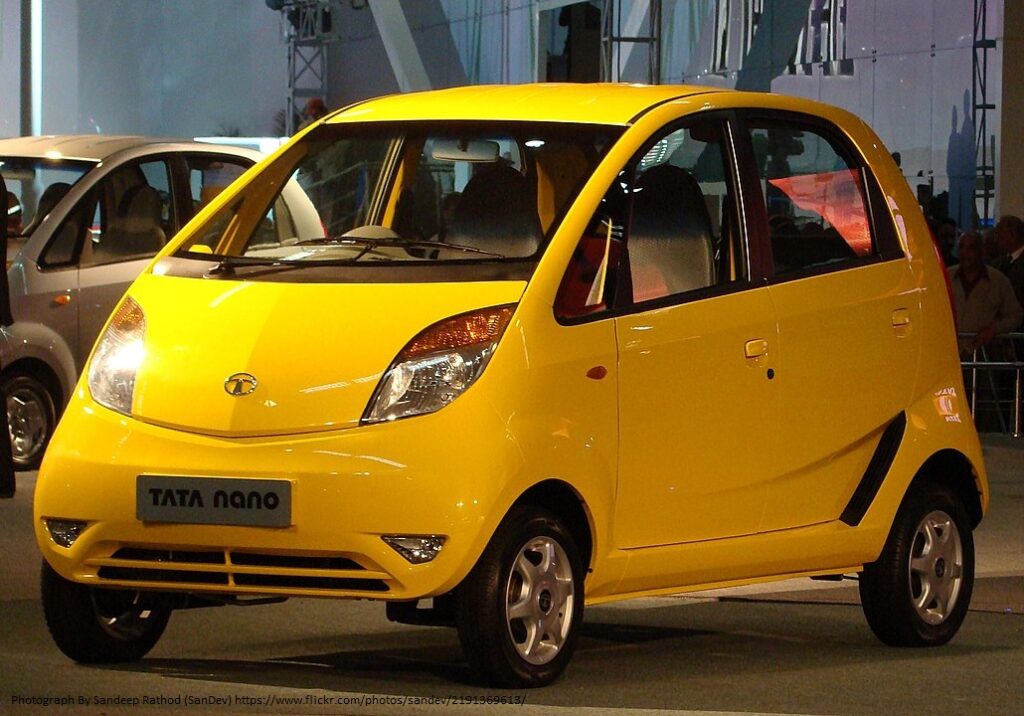At launch in 2009 the Tata Nano became the cheapest car in the world…
It cost just £1,277, but unfortunately, was only available in India.
In India it was hailed as the people’s car and got more media attention than any other car in the world, at the time.
Although, one regret, was there was never an electric vehicle version made before production officially stopped in Spring 2020.
It achieved the biggest sales uptake in the history of the global automobile industry, selling 200,000 units within the first two weeks.
Why was this tiny car initially so successful?
At the time (which is probably still the case) the motorcycle was the most popular mode of transport, due to being much cheaper than a motor car, although the problem was passenger space.
This is where Tata saw a gap in the market for the Nano.
Like the passenger car, the Tata Nano offered a safe, comfortable, reliable, and respectable all-weather means of transport for Indian families.
At the same time, Tata priced the Nano against the far-lower-cost two wheeled (motorcycle) vehicle market, that most Indian families could afford and relied on.
Solving the two problems most Indian families faced. Affordability and space. The Nano was priced like a motorcycle and provided passenger car space for families (complete with 4 doors).
Yet despite solving these problems the Tata Nano’s initial success wasn’t sustained, why?
When analysed, it seems, sales slowed due to a major weakness in the people proposition for a critical external stakeholder group, whose co-operation Tata depended on.
Tata was unable to secure the co-operation of the Singur community in West Bengal, where Tata set out to establish its manufacturing facilities.
The dispute was mainly about the leasing of arable land for industrial use, the negotiation process and level of compensation for the local owners in the community.
This misalignment caused Tata Nano’s massive facility relocation and the story of how they treated the Singur community has spread throughout India, severely dampening the Nano’s early success.
You could say, it’s a misalignment that the Nano has never recovered from, as reports say, they only sold 1 Nano in the whole of 2019, against an initial 200,000 in the first two weeks.
It shows the importance of making sure you’re aligned to the needs of your stakeholders.
Take an industry we’re involved with (electric vehicle chargers), which is in the early stages of its product lifecycle and will further mature as electric vehicle and battery technology progress.
The challenge the stakeholders (those that sell, lease, finance or purchase electric cars) have, is to find an installer who can guarantee a fast and safe electric vehicle installation repeatedly.
You see, many installers are electricians, who don’t specialise in EV charger installations, instead they try to fit them in-between rewiring a house, installing spotlights, or swapping a consumer unit.
Which leads to a disconnect with the stakeholders, as the stakeholders are unsure when they’ll turn up, how long it’ll take them to finish the job or even if the installation has been carried correctly.
The stakeholders (for us) are the most important people, and the product we provide must address their issues before alignment is possible.
Which is why, we specialise in installing home and workplace EV chargers (and don’t rewire houses or install spotlights), allowing us to provide a 14-day safe installation guarantee.
Our technicians operate under our IET 18th Edition and NICEIC approved contractor accreditations, with City & Guilds Level 3 passes for domestic and commercial EV charging installations. Together, with passing training courses on how to install each individual manufacturer EV charging units.
This level of expertise is coupled with our rigorous installation process, which results in an optimised, hassle free, and safe experience for our customers, providing peace of mind.
…aligning with stakeholders is the difference of success or failure, as the Tata Nano discovered.


